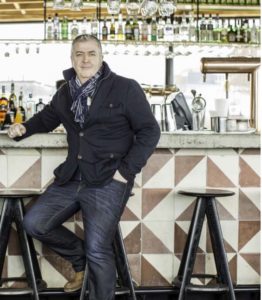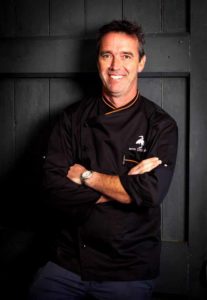Food is the Future
Pub food is forecast to grow at 2.2% over the next four years.
In opening the LVA’s recent ‘Food is the Future’ seminar LVA Chair Deirdre Devitt referred to the higher levels of competition in the licensed trade, telling a packed room in the Westbury Hotel, “Our competition today is not just other pubs, it’s artisan markets, little restaurants, big restaurants and cafés”.
With food playing an increasingly important role in today’s pub, the conference focused on the various elements that need to be considered to make one’s food offering a success.
Bord Bia’s Maureen Gahan
Bord Bia’s Foodservice Specialist Maureen Gahan, who heads up its Irish Foodservice Programme, pointed out that this year’s Irish Foodservice Channel Insights shows pubs as having 20% of the commercial foodservice market where hotels hold only 19%, full-service restaurants 13% and coffee shops/cafés 5%.
Maureen also highlighted the top four trends in foodservice:
Health & Wellbeing – consumers seek less sugar or salt in their food and she advised including healthier options on menus, catering for those with special dietary needs and offering a healthier children’s menu.
Technology – fuelled by the ever-growing population of smartphones & tablets leading to younger consumers ordering online for home delivery. This trend has been symbolized by companies like Deliveroo, now delivering alcohol in Dublin and Galway.
Provenance & Authenticity – offering ‘food with integrity’, provides consumers with information about the local suppliers and even opportunities to “meet the makers” on occasion. Maureen suggested knowing the source of the product if sourcing from a distributor and using the opportunity to feature suppliers on menus and websites. If there’s a story to tell, ensure that it’s being told.
‘Channel Blur’ – where markets merge together, for example the Grab & Go franchise now offered by convenience stores and forecourts.
In the UK, Starbucks Reserve and Costa Coffee now open late, offering alcohol to customers. Maureen wondered if publicans were doing anything in the Food-to-Go space – were they maximising coffee sales? If not, could they be?
She also offered the audience four broad trends that could be seen in pubs, mostly in Ireland:
Premiumisation where craft beer sales have grown eleven-fold since 2011. Similarly craft whiskeys have grown alongside the global growth of Irish whiskey.
Non-alcoholic premium offerings have also seen growth in demand.
Food & Drink Pairings have resulted from the consumer becoming more adventurous. This now forms a core feature of many modern pub food offerings.
Multiple concepts which see pubs offering more than originally planned. Some offer breakfast and lunch in addition to the drink offer, some offer cocktails or have added on a late-night venue or high-end restaurant – some combine all these in the one premises.
Musgrave Wholesale Partner’s Noel Keeley
 Noel Keeley, Managing Director of Musgrave MarketPlace, spoke about the growing food business in pubs.
Noel Keeley, Managing Director of Musgrave MarketPlace, spoke about the growing food business in pubs.
Musgrave’s new concept ‘MarketPlace’ replaces the old Cash & Carry business with a multi-channel food and drink wholesaling offer.
He pointed out that some 600,000 Millennials live in the capital, providing huge opportunity for food providers.
Obsessed with ‘selfies’ and facebook etc, they’re the ‘new consumer’. Forget them at your peril, he cautioned. So much content on facebook is now about food.
They go on the internet firstly to ‘know’, then to ‘go’, to ‘buy’ and to ‘do’, so without a presence on social media, you simply don’t exist for them, he said.
People now assume that food will end up pictured on facebook so presentation has become all-important.
Social media can be an inexpensive marketing tool which could have a huge effect on your business, but the downside of this is that if the comments are not complimentary, it could be destructive for the business concerned.
Many pre-packaged products help the busy pub chef avoid preparation and labour time and thus costs, providing a better margin but much regulation is on the way in this space, he warned.
Premiumisation too was a growing trend where, instead of the regular spirit & mixer at a unit price, a premium offering could be sold to the customer at a premium price providing a significant margin difference.
“It could be €11 or €12 for something perceived as being better quality and better presented in a nicer glass as opposed to €6 to €7.”
It was the same for perceptions and margins on craft beer, he added.
“They might not drink as much, but they’re paying for it, so there’s a better cash margin and if it’s a good experience for them, they’ll stay longer.
“We’re seeing a more sophisticated consumer who wants to see that some one gave their offering some thought and that it’s therefore going to enhance the experience that they’re having.”
Bunzl Catering Design Solutions’ Ken Lynch
Ken Lynch, Business Development Manager for Bunzl Catering Design Solutions, told the seminar that as alcohol sales decline, coffee sales are growing.
“The coffee market is expected to grow by about 12% to 2018,” he said.
He referred to Millennials ‘comfort eating’ where food and drink helps them express who they are.
His business lay in planning and installing foodservice operations and he advised anyone thinking of installing a new kitchen to pay special attention to knowing their menu thoroughly in terms of margins, catering requirements and catering space required.
“Know your market and talk to the experts, go for a consultant when designing up a kitchen,” he stated.
There were many aspects to consider in a new kitchen including temperature control, grease extract systems (which could cost anything between €2,000 and €6,000) and settling on the most cost-effective equipment over the course of its lifetime.
He believed in having a ‘home for everything’ planned out in advance as there was frequently an underestimation of the necessary storage space required in catering. For example, chemicals and other substances hazardous to health require separate isolated storage.
Staff need to be looked after too in planning. They need to have their own space.
“And examine long-term energy costs when purchasing,” he advised the seminar, “The government is pushing more energy-efficient equipment, so invest wisely.”
Catering equipment could have a lifespan of 10 to 15 years, so understand that the energy-saving percentage offer provides significant savings over the course of the lifetime of the equipment.
O’Donnell O’Neill Design’s Graham O’Donnell
Graham O’Donnell believes that the food direction dictates the design style (size of table for example or the table height relative to the seating height).
Is it to be an open or closed kitchen style?
Graham believes there’s nothing worse than an open kitchen that’s closed at a particular time of night. And when adapting to or from bar mode, there should be no lingering smells from the previous activity.
While lighting is crucial to good atmosphere, lighting levels must enable customers to see menus and see food presentation in a natural light. Lighting should also be dimmable and zoned correctly, he added.
Old Spot Bar/Loyola Group’s Stephen Cooney
Publican Stephen Cooney set about answering the question ‘What is a gastropub?’.
“A gastropub is defined as a bar and restaurant that serves higher-end beer and food,” he told those present.
The Loyola Group also holds a significant investment in Base Wood Fired Pizza’s five Dublin outlets.
“Food represents 50% of our turnover,” he said, “without the ‘Base Pizzas’, it’s about 35%”.
In the case of The Old Spot, local artisan and seasonal food is prepared fresh every morning while the décor in the pub is kept casual, in keeping with the pub’s customers.
A good variety of drink is also on offer and staff are trained to be informal, personable and chatty, but not over-familiar – and a good chef is essential.
“But you need to sell a lot of food to be able to afford one,” he warned.
Stephen believes that there are four key components to the success of the Old Spot pub.
Layout & Décor – in his opinion the pub offered a good blend of eating and drinking space. It also created some theatre in its food offerings. Additionally, the beer taps are accessible and avoid use of the swan necks which, he believes, tend to prohibit conversation between the barman and the customer, adding that “good wine glasses are necessary for high-end food”.
Food Quality & Drink Variety – ‘Fast casual’ is becoming very big and this will hit the pubs. The Old Spot changes its specials daily and makes a point of having good menu layout. It’s also imperative to maintain the standards you set originally. The wide variety of drinks available also includes some expensive wines as he’s seeing the re-emergence of corporate spending on wine.
Marketing & Online Presence – Around 50 good quality professional photographs are taken every quarter to keep the website up-to-date.
Online booking has also grown from around 10% initially to around 35% today.
He advised that online bloggers should always be responded to by the pub’s social media tracker and to follow-up corporate bookings to get feedback. It’s good marketing.
Staff – His staff use a booking system that enters any customer complaint into that customer’s diary so that the next time, staff can refer to it to show that they haven’t forgotten.
In order to help with staff recruitment and training he’d like to see government introduce some tax-based incentives for training up staff to standard.
Dunbrody House’s Kevin Dundon
A partner in the Raglan Road Irish pub operation in Orlando, Florida, Kevin Dundon of Dunbrody House has installed a pub – The Local – with a small kitchen in his Wexford operation.
He likes to use what’s around him for the menu. This has two advantages, he says, “Freshness, plus buy-in from the local community”.
Kevin demonstrated three dishes to the audience that he said are easy to make: Lollipop of Pork, Seafood Chowder and a Jacob’s Ladder meat dish.
The food source that supplies you usually has a great story to tell which you can pass onto your customers.
With space at a premium in pubs, he’s a keen advocate of vacuum-packing off-premises and only bringing in what you need. Vacuum-packing extends the shelf-life by up to seven days and a vacuum-packer is probably the most important machine in the kitchen, he explained after the conference.
Vacuum-packing can even be done with toasted sandwiches so they can be prepared with the best of ingredients off-premises, vacuum-packed and brought into the pub as and when required.
It can prove very profitable if done well. In New York’s Spotted Pig, customers pay $25 for a toasted sandwich.
LVA Chief Executive Donall O’Keeffe summed up the seminar stating, “Pubs are well-placed to take advantage of the quick casual food market and now is a good time to be taking advantage of it”.













